Nuclear submarines with cruise missiles. 670 Skat Project (Charlie-I class)
After considering several proposals of the design bureau, the terms of reference for the development of a cheap and relatively simple nuclear submarine of project 670 (code “Skat”), which was optimized to combat surface targets, were issued in May 1960 to Gorky SKB-112 (in 1974 it was renamed to TsKB “ Lapis lazuli"). This young team of designers, formed at the Krasnoye Sormovo plant in 1953, had previously worked on project 613 diesel-electric submarines (in particular, SKB-112 was preparing documentation that was handed over to China), so the first nuclear-powered ship was created for SKB a serious test. Vorobiev V.P. was appointed chief designer of the project, and Mastushkin B.R. - the main observer from the naval fleet.
The main difference of the new ship from the SSGN of the 1 generation (659 and 675 projects) was the equipment of the submarine with the Amethyst anti-ship missile system, having the possibility of an underwater launch (developed by OKB-52). 1 April 1959, the government issued a decree according to which this complex was created.
One of the most difficult problems during the development of a new nuclear submarine project with cruise missiles, the serial construction of which was to be organized in the very center of Russia - in Gorky, at a distance of a thousand kilometers from the nearest sea, was to keep the displacement and dimensions of the ship within transportation of the submarine on inland waterways.
As a result, the designers were forced to accept, as well as "punch" at the customer some unconventional for the domestic fleet of those. decisions that are contrary to the "Rules for the design of submarines." In particular, they decided to switch to a single-shaft scheme and sacrifice the provision of surface buoyancy in the event of flooding of any waterproof compartment. All this made it possible to keep within the framework of the draft design in the normal displacement of 2,4 thousand tons (however, during the further design this parameter increased, exceeding 3 thousand tons).
In comparison with other submarines of the second generation, which were designed for a powerful, but rather heavy and large-sized Rubin hydroacoustic complex, on the 670 project it was decided to use the more compact hydroacoustic complex Kerch.
In OKB-52, in 1959, a draft design of the Amethyst rocket complex was developed. Unlike the first-generation Chelomeyev anti-ship missiles, the P-6 and -35, which used a turbojet engine, they decided to use a solid-propellant rocket engine on a submarine-launched rocket. This significantly limited the maximum range of fire. However, at that time there was simply no other solution, because at the technological level of the end of 1950, it was not possible to develop a system for launching an air-jet engine during the flight, after the launch of the rocket. In 1961, tests of Amethyst anti-ship missiles began.
Approval of those. The new nuclear submarine project took place in July 1963. The nuclear submarine with cruise missiles of the 670-th project had a double-shell architecture and fusible contours of the light hull. The nose of the hull had an elliptical section, which was caused by the placement of rocket weapons.
The use of large-scale gas systems and the desire to provide these systems in the feed sectors with the maximum possible viewing angles became the cause of the nasal obtrusion. In this regard, some of the devices were placed in the nasal tip of the upper part of the light body. Horizontal front rudders (for the first time for domestic submarine shipments) were shifted to the middle part of the submarine.
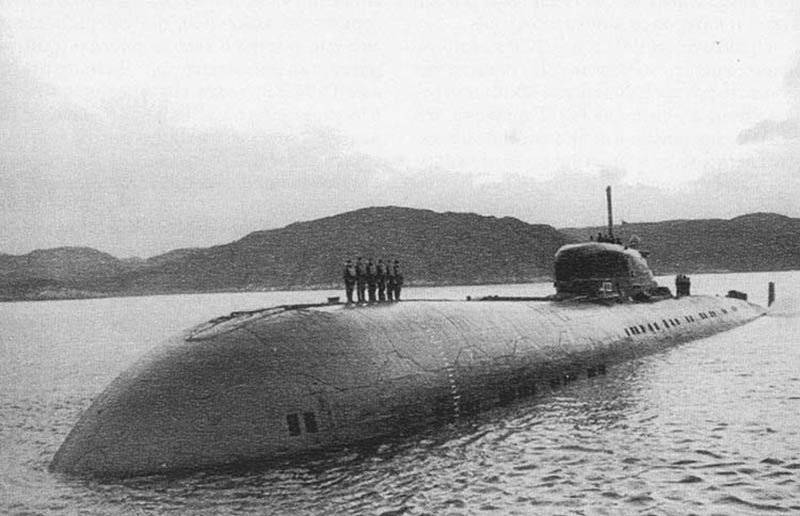
AK-29 steel was used to make a robust case. Over the length of the 21 meter in the forward end, the rugged casing had the shape of a triple-eight, which was formed by cylinders of relatively small diameter. This form was determined by the need to place rocket containers in a lightweight body. The submarine hull was divided into seven waterproof compartments:
The first compartment (made up of three cylinders) - battery, residential and torpedo;
The second compartment is residential;
The third compartment is the battery, central post;
The fourth compartment is electromechanical;
The fifth compartment is the reactor compartment;
The sixth compartment is a turbine;
The seventh compartment is electromechanical.
The end nasal septum and six intersect bulkheads are flat, designed for pressures up to 15 kgf / cm2.
For the manufacture of light hull, solid cutting and ballast tanks, low-magnetic steel and AMG were used. Aluminum superstructure was used for the superstructure and fencing of sliding devices. The fairings of hydroacoustic antennas, the permeable parts of the aft tip, and the tail feathers are made using titanium alloys. The use of dissimilar materials, which in some cases form galvanic vapors, required special measures to protect against corrosion (gaskets, zinc protectors, etc.).
To reduce the hydrodynamic noise when driving at high speeds, as well as to improve the hydrodynamic characteristics for the first time in the domestic submarines used mechanisms for closing ventilating and scuttle holes.
The main power plant (power 15 ths. Hp) was largely unified with twice the more powerful power plant of the high-speed atomic submarine of the 671 project — the one-reactor steam generating plant OK-350 included a water-cooled reactor VM-4 (power 89,2 mW) . The GTZA-631 turbine was driven into rotation by a five-blade propeller. There were also two auxiliary electric waterways (270 kW), which provided the ability to travel at speeds up to 5 nodes.
On the 670 boat of the project, as well as on other submarines of the second generation, a three-phase alternating current with a frequency of 50 Hz and a voltage of 380 B was used in the system of generating and distributing electricity.
The ship is equipped with two autonomous turbo-generators TMVV-2 (power 2000 kW), 500-kilowatt diesel alternator with an automated remote control system and two groups of batteries (each with 112 elements).
To reduce the acoustic field of the SSGMs, soundproofing damping of the mechanisms and their foundations was used, as well as facing of deck decks and bulkheads with vibration-damping coatings. All outer surfaces of the light hull, felling fence and superstructure were sheathed with rubber anti-roll coating. The outer surface of the durable body covered similar material. Thanks to these measures, as well as single-turbine and single-shaft layout, the SSGN of the 670 project had a very low, for that time, level of acoustic visibility (among the second-generation Soviet nuclear-powered ships, this submarine was considered the lowest noise level). Its noise at full speed in the ultrasonic frequency range was less than 80, in the infrasonic - 100, in the sound - 110 decibels. At the same time, most of the acoustic range and natural sea noise coincided. On the submarine there was a degaussing device designed to reduce the magnetic visibility of the vessel.
The hydraulic system of the submarine was divided into three autonomous subsystems, which served to drive general ship devices, rudders, rocket container covers. The working fluid of the hydraulic system during the operation of the submarines, which, due to its high fire risk, was the subject of a constant “headache” for the crews, was replaced by a less flammable one.
The SSGN of the 670 project had an electrolysis stationary air regeneration system (this made it possible to abandon another source of fire danger on the submarine — regeneration cartridges). The system of freon volumetric fire extinguishing ensured effective fire fighting.
The submarine was equipped with the Sigma-670 inertial navigation system, the accuracy of which exceeded the corresponding characteristics of the navigation systems of first-generation boats 1,5 times. Kerch Kerch ensured a detection range in 25 thousand meters. Onboard the boat for control of the combat systems was placed the BEST information control system (combat information and control system).
On the ship 670-th project compared with the first-generation ships have dramatically increased the level of automation. For example, automated control of the movement of the submarine at the rate and depth, stabilization without running and on the move, the process of ascent and immersion, the prevention of accidental dips and trim, control preparation for torpedo and missile firing, and the like.
Several improved and habitability on the submarine. All personnel were provided with individual beds. The officers had a mess room. Dining room for midshipman and sailor composition. Interior design has improved. On the submarine used fluorescent lamps. In front of the cabin fencing there was a shuttle pop-up rescue chamber designed to rescue the crew in an emergency (ascent from depths to 400 meters).
The missile armament of the SSGN of the 670 project — eight Amethyst anti-ship missiles — was located in the CM-97 container launchers placed outside the strong hull in front of the ship at an angle 32,5 of degree to the horizon. The P-70 solid propellant rocket (4K-66, the NATO designation SS-N-7 "Starbright") had a launch weight of 2900 kg, maximum range 80 km, speed 1160 kilometers per hour. The rocket was carried out according to the normal aerodynamic scheme, had a folding wing that opens automatically after launch. The flight of the rocket took place at an altitude of 50-60 meters, which made it difficult to intercept the air defense of enemy ships. The radar homing system of anti-ship missiles provided automatic selection of the largest target in the order (that is, the target that has the largest reflective surface). Typical submarine ammunition consisted of two missiles equipped with nuclear ammunition (power 1 kt) and six missiles with conventional warheads weighing about 1000 kg. Fire with anti-ship missiles could be carried out from a depth of up to 30 meters by two four-rocket volleys at speeds under boats up to 5,5 nodes, with waves of the sea less than 5 points. A significant drawback of the Amethyst P-70 missiles was the strong smoke trail left by the solid-propellant rocket engine that unmasked the submarine during the launch of anti-ship missiles.
Submarine torpedoes 670 project was placed in the bow of the vessel, and consisted of four 533-millimeter torpedo tubes with ammunition twelve torpedoes SET-65, SAET-60M ili53-65K and two 400- mm torpedo tubes (four torpedoes MGT-2 or SET-40). Instead of torpedoes, the submarine could carry up to 26 minutes. Also, the submarine torpedo ammunition consisted of false targets “Anabar”. To control the torpedo firing served as the PUS system "Ladoga-P-670".
In the West, the submarines of the 670 project were given the designation "Charlie class". It should be noted that the emergence of new missile-carriers in the composition of the USSR Navy significantly complicated the life of the US Navy’s aircraft carrier formations. Possessing less noise than their predecessors, they were less vulnerable to potential enemy antisubmarine weapons, and the possibility of underwater missile launch made using their “main caliber” more effective. The low range of firing with the Amethyst complex required an approach to the target at a distance of 60 – 70 kilometers. However, this also had its advantages: a short flight time of low-altitude transonic missiles made it very problematic to organize counteraction to a water strike from “dagger” distances.
Modifications
Five SSGNs of the 670 project (K-212, -302, -308, -313, -320) were upgraded in 1980's. Hydroacoustic complex "Kerch" was replaced by the new SAC "Rubicon". Also, on all submarines in front of the fence of sliding devices, a hydrodynamic stabilizer was installed, which was a plane with a negative angle of attack. The stabilizer compensated for the excessive buoyancy of the “swollen” nose of the submarine. On some submarines of this series, the previous propeller was replaced by new low-noise four-blade screws with a diameter of 3,82 and 3,92 m, installed on the same shaft in tandem.
In 1983, an atomic submarine with K-43 cruise missiles, slated for sale to India, underwent a major overhaul and modernization under the 06709 project. As a result, the submarine received Rubicon hydroacoustic complex. Also in the course of the work, an air-conditioning system was installed, new control rooms were installed for the personnel and cabins for officers, and secret control and communications equipment was removed. After completing the training of Indian crews, the submarine again stood up for repair. By the summer of 1987, she was fully prepared for the transfer. 5 January 1988 of the year K-43 (renamed TCB-550) in Vladivostok raised the Indian flag and departed for India.
Later, on the basis of the 670 project, an improved version of it was developed - the 670-M project - which has more powerful Malachite rockets, whose firing range was up to 120 kilometers.
Construction program
In Gorky, on the Krasnoe Sormovo CVD, in the period from 1967 to 1973, eleven SSGNs of the 670 project were built. After transportation to special. the docks along the Volga, the Mariinsky water system and the White Sea-Baltic Canal, the submarines were transferred to Severodvinsk. They made their completion, testing and delivery to the customer. It should be noted that at the initial stage of the program implementation, the option of transferring the SSGN of the 670 project to the Black Sea was considered, but it was rejected mainly for geopolitical reasons (the problem of the Black Sea straits). 6 November 1967 of the year was signed by the acceptance act of K-43 - the lead ship of the series. 3 July 1968, after testing on the K-43 submarine, the Amethyst missile system with the P-70 missiles was accepted into service by the Navy.
In 1973-1980, 6 submarines of the modernized 670-M project were built at the same plant.
Status on 2007 year
The K-43, the head nuclear submarine with cruise missiles of the 670 project, became part of the Eleventh Division of the First Fleet of Northern Fleet submarines. Later, the rest of the 670 vessels were included in this connection. Initially, the SSGN of the 670-th project was listed as the KPLP. 25 July 1977 of the year they are assigned to a subclass of BPL, but 15 of January of the following year are again assigned to the KPLP. 28 April 1992 of the year (individual submarines - June 3) - to the subgroup ABPL.
Project 670 submarines began to carry out military service in 1972. The submarines of this project monitored the aircraft carriers of the US Navy, were actively involved in various exercises and maneuvers, the largest - Ocean-75, North-77 and Run-81. In 1977, the first group firing of Amethyst anti-ship missiles was carried out as part of 2 SSGNs of the 670th project and the 1st small missile ship.
One of the main areas of service combat ships project 670 was the Mediterranean Sea. In this region in 1970-80-ies. the interests of the USA and the USSR were closely intertwined. The main objective of the Soviet missile-carriers - warships of the Sixth US Navy. It must be recognized that the Mediterranean conditions made the 670 submarines of this theater the most formidable weapons. Their presence caused a reasonable concern to the American command, which did not have at its disposal reliable means of counteracting this given threat. A spectacular demonstration of the capabilities of the submarines in service with the USSR Navy was missile target firing conducted by the K-313 submarine in May 1972 in the Mediterranean.
Gradually, the geography of campaigns of the North Sea submarines 670-th project expanded. In January-May, 1974 of the year K-201, together with the nuclear submarine K-314 of the 671 project, made a unique 107-daily transition from the SF to the Pacific Ocean through the Indian Ocean via the southern route. 10-25 March submarines entered the Somali port of Berbera, where the crews received a short rest. After this, the voyage continued, ending in Kamchatka in early May.
K-429 in April 1977 of the year made the transition from the Northern Fleet to the Pacific Fleet by the Northern Sea Route, where the SSGN 30 of April 1977 of the year became part of the Tenth Division of the Second Flotilla of submarines based on Kamchatka. A similar transition in August-September 1979 of the year, lasting 20 days, was made by the K-302 submarine. Subsequently, K-43 (1980 year), K-121 (up to 1977 year), K-143 (1983 year), K-308 (1985 year), K-313 (1986 year) arrived on the Pacific Ocean via the Northern Sea Route.
K-83 (renamed K-1978 in January 212) and K-325 in the period from August 22 to 6 September 1978 made the world's first trans-Arctic trans-Arctic group transition in the world. Originally it was planned that the first submarine, passing from the Barents Sea to the Chukchi Sea under the ice, would give a signal to ascend, after which the second ship would set off. However, they offered a more reliable and efficient way of transition - a transition within the tactical group. This reduced the risk of submarine sailing of one-reactor boats (in the event of the failure of one of the SSARCs of the reactor, the other boat would be able to assist in the search for the openings). In addition, the boats in the group were able to communicate with each other over the telephone using UZPS, which allowed the submarines to interact with each other. In addition, the group transition reduced the cost of the surface (“pre-ice”) security issues. The commanders of the ships and the commander of the Eleventh Submarine Division were awarded the title Hero of the Soviet Union for participation in the operation.
All Pacific ships of the 670 project were part of the Tenth Division of the Second Submarine Flotilla. The main objective of the submarines was tracking (upon receipt of the appropriate order - destruction) of US Navy aircraft carriers. In particular, in December 1980, the K-201 submarine carried out a long-term follow-up of a strike carrier group led by the aircraft carrier Coral Sea (for which it was commended by the Commander-in-Chief of the Navy). Due to the lack of anti-submarine submarines in the Pacific Fleet, the SSGN of the 670 project was attracted to solve the problems of detecting American submarines in the combat patrol area of Soviet SSBNs.
The fate of K-429 has developed most dramatically. 24 June 1983 of the year as a result of an error by the crew of a submarine sank at a depth of 39 meters in the Sarannaya Bay (near the coast of Kamchatka) at a combat training ground. The incident killed 16 people. The 9 submarine in August 1983 was raised (an incident happened during the lifting operation: “additionally” flooded four compartments, which made the work much more difficult). The refurbishment, which cost the treasury 300 million rubles, was completed in September 1985 of the year, but 13 September, a few days after the work was completed, as a result of violations of the survivability requirements, the submarine sank again in the Big Stone at the SRH wall. In 1987, the submarine that was not commissioned was expelled from the fleet and reequipped into the training station UTS-130, which is based on Kamchatka and is used for sowing day.
Following the submarine K-429, which left the battle formation in 1987, at the beginning of the 1990-s, other submarines of the 670 project were also written off.
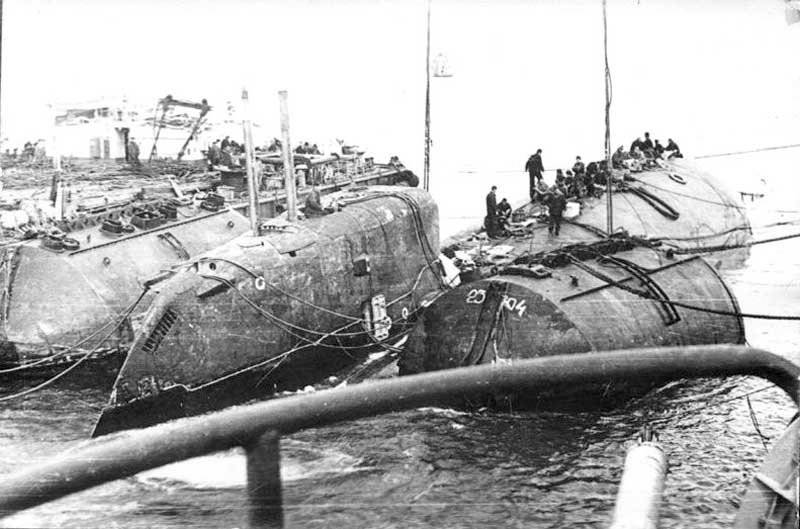
One of the ships of the 670 project, the K-43, was the first nuclear submarine of the Indian Navy. This country is at the beginning of the 1970's. launched a national program to create nuclear submarines, but seven years of work and four million dollars spent on the program did not lead to the expected results: the task turned out to be much more difficult than it seemed at first. As a result, they decided to rent one of the submarines from the USSR. The choice of Indian sailors fell on Charlie (in the Pacific Theater, ships of this type have proven themselves well).
In 1983, in Vladivostok, at the Navy training center, and later aboard the K-43 submarine, scheduled for transfer to the Indian Navy, training of two crews began. By this time, the submarine has already passed the overhaul and modernization of the project 06709. The boat, after completing the training of Indian crews, again stood up for repair. By the summer of 1987, it was fully prepared for the transfer. K-43 (received the designation UTS-550) 5 January 1988 of the year raised the flag of India in Vladivostok and a few days later went to India with a Soviet crew.
For the new, powerful warship of the Navy of India, which received the tactical number S-71 and the name "Chakra", very favorable home conditions were created: spec. pier equipped with 60-ton crane, indoor dock boathouse, radiation safety services, workshops. Water, compressed air and electricity were supplied to the boat during the stay. In India, “Chakra” was operated for three years, while she spent about a year in autonomous voyages. All conducted training firing crowned direct hits on target. 5 January 1991, the submarine rental period has expired. India persistently tried to extend leasing and even buy another similar submarine. However, Moscow did not agree to these proposals for political reasons.
For Indian submariners, Chakra was a real university. Many of the officers who served on it today occupy key posts in the naval forces of this country (suffice it to say that a nuclear submarine with cruise missiles gave India 8 admirals). The experience gained during the operation of the atomic-powered vessel made it possible to continue work on the creation of its own Indian nuclear submarine S-2.
28 April 1992 of the year “Chakra”, newly enrolled in the Russian Navy, arrived in Kamchatka under its own power, where it completed its service. 3 was expelled from the 1992 of July XNUMX of the fleet.
The main tactical and technical characteristics of PLKR project 670 "Scat":
Surface displacement - 3574 tons;
Underwater displacement - 4980 tons;
Dimensions:
The greatest length - 95,5 m;
The greatest width - 9,9 m;
Draft on KVL - 7,5 m;
Main power plant:
- steam generating plant OK-350; VVR VM-4-1 - 89,2 mW;
- GTZA-631, steam turbine, 18800 hp (13820 kW);
- 2 turbogenerator TMVV-2 - 2х2000 kW;
- diesel generator - 500 kW;
- Auxiliary ED - HP; 270;
- shaft;
- Five-bladed VFSH or 2 according to the “tandem” scheme;
- 2 auxiliary water jet;
Surface speed - 12 nodes;
Submerged travel speed - 26 nodes;
Immersion depth - 250 m;
Extreme depth of immersion - 300 m;
Autonomy 60 days;
Crew - 86 people (including officer 23);
Impact rocket armament:
- Launchers SM-97 anti-ship missile system P-70 "Amethyst" - 8 pcs .;
-P-70 anti-ship missiles (4K66) "Amethyst" (SS-N-7 "Starbright") - 8 pcs .;
Torpedo armament:
- 533-mm torpedo tubes - 4 (bow);
- 533 mm torpedoes 53-65К, САЭТ-60М, СЭТ-65 - 12;
- 400-mm torpedo tubes - 2 (bow);
-400 mm torpedoes SET-40, MGT-2 - 4;
Mine armament:
- can carry up to 26 minutes instead of torpedoes;
Electronic weapons:
Combat information and control system - "Brest"
Radar system of general detection - RLK-101 "Albatross" / MRK-50 "Cascade";
Hydroacoustic system:
- hydroacoustic complex “Kerch” or CIM-400 “Rubicon” (Shark Fin);
- RFP;
Means of electronic warfare:
- MRI-21A "Zaliv-P";
- “Paddle-P” direction finder;
- VAN-M PMU (Stop Light, Brick Group, Park Lamp);
- GPA "Anabar" (instead of part of the torpedoes);
Navigation complex - "Sigma-670";
Radio communication complex:
- "Lightning";
- “Paravan” buoy antenna;
- “Iskra”, “Anis”, “Topol” of the PMU.
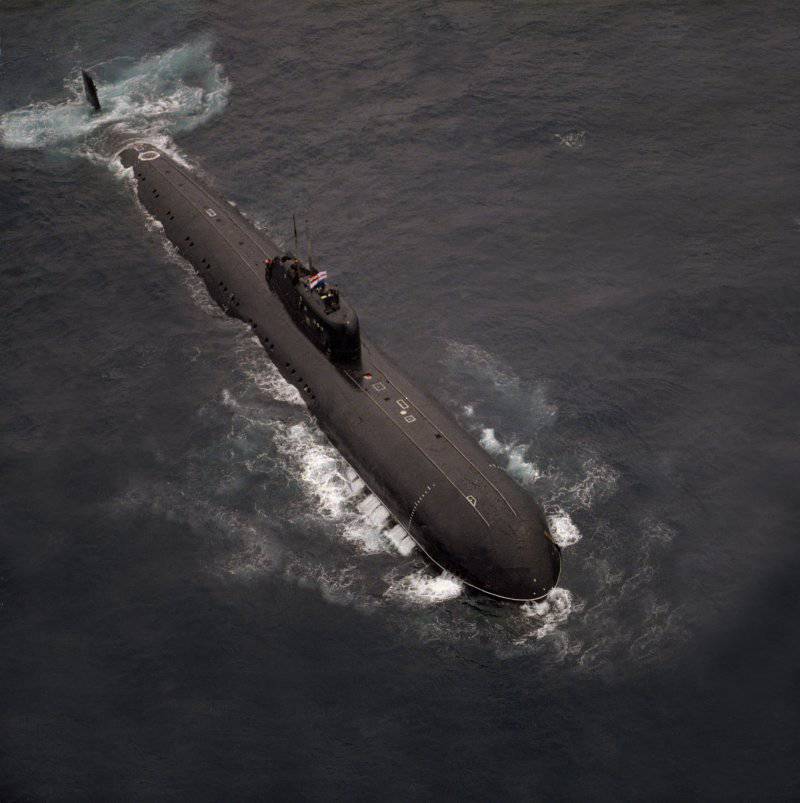
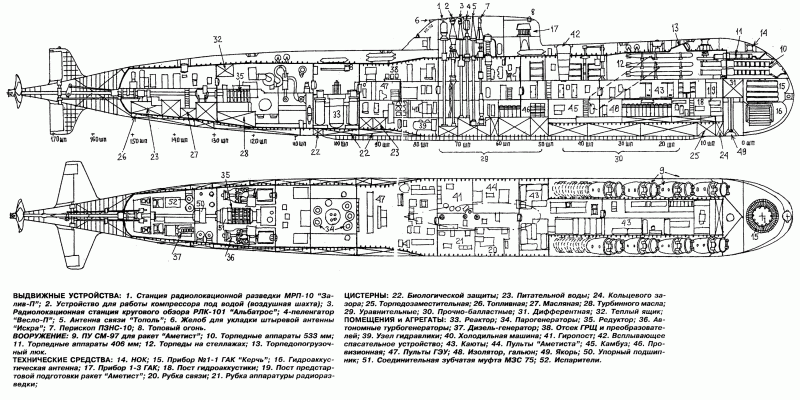
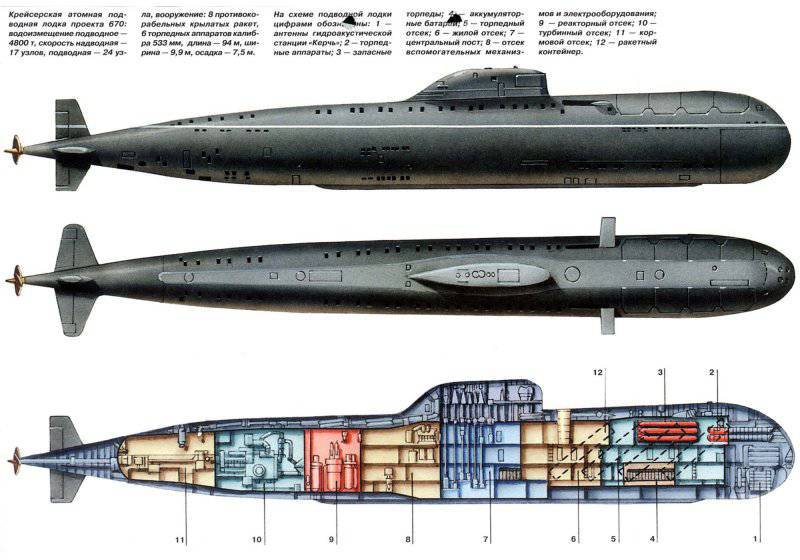
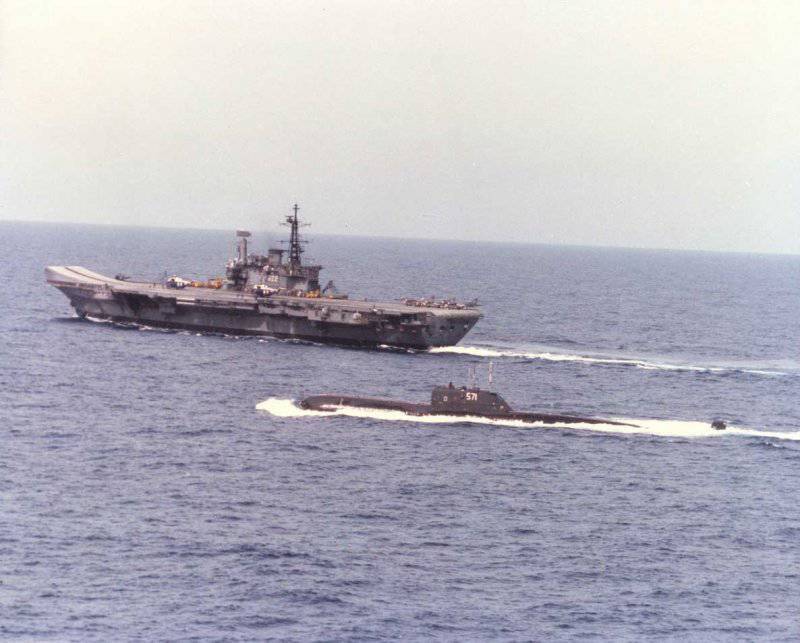
Information